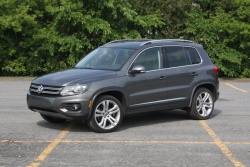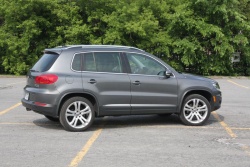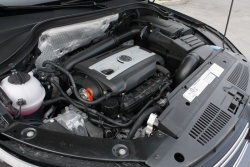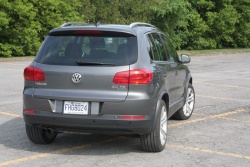 2012 Volkswagen Tiguan Highline. Click image to enlarge |
|
Test Drive: 2012 Volkswagen Tiguan Highline
Manufacturer’s web site |
Review and photos by Chris Chase
Photo Gallery:
2012 Volkswagen Tiguan
Sometimes, made-up words work as car names; other times they don’t. When Volkswagen let the German public name its first compact crossover utility vehicle (CUV) and they chose Tiguan (a hybrid of the German words for tiger and iguana), well, that was one of those ‘other’ times. Surely there must have been another North African tribe (Touareg) or wind (Passat, Jetta, Scirocco) they could have named it for.
For better or worse, Tiguan it was in 2009, and it continues to be for the vehicle VW pits against some of the biggest-selling names in Canada, such as CR-V, RAV4 and Escape. As is the Volkswagen way, this car is positioned as a slightly upscale alternative to the household names in the category.
 2012 Volkswagen Tiguan Highline. Click image to enlarge |
The most obvious change for 2012 is in the Tiguan’s appearance, which gets an edgy update to bring it in line with the rest of the VW range. The only part I’m not keen on is the amphibious-vehicle look of the front bumper, which looks especially ungainly with my tester’s optional 19-inch wheels.
The tailgate is new, too, so why not take the opportunity to integrate the release handle into the VW badge, a la Golf? Instead, they left the only means of opening the tailgate down at the bottom of the door, where it will spend all winter and every rainy day being one of the dirtiest parts of the car.
Inside, 2012 brings new air conditioning controls and steering wheel. Thankfully, the cool round dash vents were left alone.
Volkswagen’s 2.0L turbocharged, four-cylinder FSI engine is carried over with its power ratings of 200 horsepower and 207 lb-ft of torque intact. A six-speed automatic transmission (standard in all but the base front-drive model) is carried over from 2011, but with some revisions to reduce fuel consumption. Fifth and sixth gears are now both overdrive ratios, and the electronics have been reprogrammed for earlier upshifts.
 2012 Volkswagen Tiguan Highline. Click image to enlarge |
The updates make a big dent in Natural Resources Canada’s ratings for the Tiguan, which for 2012 drop to 9.8/7.4 L/100 km (city/highway) with automatic and all-wheel drive, from 11.6/8.3 for a comparable 2011 model. My tester averaged 10.2 L/100 km in city driving, falling closer in line with the U.S. Environmental Protection Agency’s more realistic figures, which work out to 11.2/8.7 L/100 km city/highway.
Good news for fuel economy fans, but this re-imagined transmission occasionally gets confused, upshifting so eagerly that it will often downshift again, mid-stream, to get the car up to cruising speeds in a realistic amount of time (a period generally defined by the impatient drivers looking at the Tiguan’s taillights). The ironic thing is that this engine, with its generous low-end torque that peaks at just 1,700 rpm, can move the Tiguan reasonably well at low revs, so the early upshifting isn’t the problem; the transmission’s indecisiveness is.
 2012 Volkswagen Tiguan Highline. Click image to enlarge |
But the gearbox’s easily confused nature is fairly common nowadays, with fuel economy being at the top of so many minds. Also common is how well the Tiguan’s drivetrain responds to a good flogging. Volkswagen’s 2.0L FSI four-cylinder turbocharged motor is as solid a performer as ever here, and the transmission gets its head on straight the heavier the driver’s right foot gets, helpfully holding onto a lower gear if it thinks you’re in the mood for speed.
That goes well with the Tiguan’s typical German driving dynamics. This little crossover moves more like a car than just about any of the other car-based vehicles it competes with. The steering is light at low speeds but returns good road feel at higher speeds, and especially when the car is tossed into a corner. The firm brake pedal is a good thing most of the time, except when you need a lot of stopping right now, and it becomes so firm it feels like it’s telling you “it’s not a good time, please come back later.” My tester had the optional Sport package, a $1,900 addition that includes 19-inch wheels and tires (too big, though the wide tires look good from the rear) and a sport-tuned suspension (too stiff). The only things worthwhile here are the adaptive (steerable) xenon headlights, but those alone aren’t worth the punishing ride and the cost of replacing 19-inch tires every three years.











